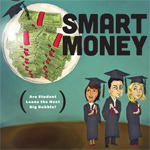
The federal Consumer Financial Protection Bureau released today its report private student loan market which shows that, according to its estimates, outstanding student loan debt in the United States topped $1 trillion in 2011 — $864 billion of federal student debt and approximately $150 billion of private student loan debt.
During the subprime housing boom in the mid-2000s, private lenders loosened their standards amid high demand from investors for loans packaged into securities.The lax standards and aggressive marketing led some people to borrow more than necessary to pay for college, the report said.
Fueled by investor appetite for asset-backed securities, the financial institution private student loan market grew from less than $5 billion in 2001 to over $20 billion in 2008, before contracting to less than $6 billion in 2011.
From 2005 – 2007, lenders increasingly marketed and disbursed loans directly to students, reducing the involvement of schools in the process; indeed during this period, the percentage of loans to undergraduates made without school involvement or certification of need grew from 40% to over 70%. As a result, many students borrowed more than they needed to finance their education. Additionally, during this period, lenders were more likely to originate loans to borrowers with lower credit scores than they had previously been. These trends made private student loans riskier for consumers.
In 2009, the unemployment rate for private student loan borrowers who started school in the 2003-2004 academic year was 16%. Ten percent of recent graduates of four-year colleges have monthly payments for all education loans in excess of 25% of their income. Default rates have spiked significantly since the financial crisis of 2008. Cumulative defaults on private student loans exceed $8 billion, and represent over 850,000 distinct loans.
In 2008, 42% of undergraduates at for-profit colleges took out a private student loan, while only 14% of all undergraduates used a private student loan.
In May 2012, the Independent News reported on the student loan crisis—Smart Money.
We interview college graduates about their student loans. As you might expect, many were reluctant to talk. We interviewed “Mary”-age 34 and with $25,000 in loans that she is trying to pay off.
She started taking out loans as a sophomore, and is still diligently paying them off. After graduating from school, Mary had trouble finding a job. It was September 2001 and much like now, the job market was tough as everyone reassessed following the 9/11 attacks.
“Obviously, 9/11 had just happened,†Mary said. “It was a horrible time to be looking for a job.â€
After moving west to San Francisco, Mary found work in her field—“the original plan, which was goodâ€â€”but the pay didn’t suffice. She moved in with a college friend and toughed out the high-cost Bay Area.
“So, yeah, that was a struggle,†she said.
Like many people, Mary decided to continue her education—this time with a for-profit institution. This doubled the amount of student loans she had.
“I was pretty naive,†Mary said.
The for-profit institution was able to steer her toward more loans, but these were not the federal Stafford loans. They were from private lenders.
“The trick is they kind of lure you back into taking student loans, but really they’re not student loans,†she said. “Really it’s just a private bank, masquerading as a student loan.â€
Following her return to school, Mary landed a job with an advertising agency. It was an internship, but it allowed her to pay the bills, including her student loan debt.
“Had a good three-year run where I was able to make my payment and everything was honky-dory,†she said.
We are still looking for more student loan stories. We will protect identity. You can email me at rick@inweekly.net.